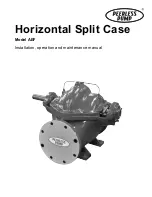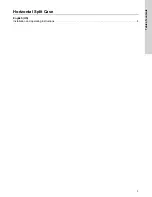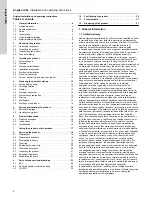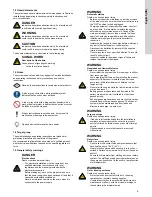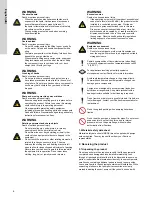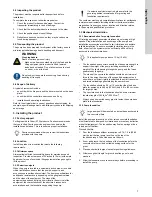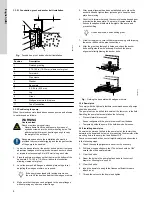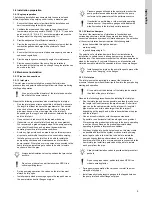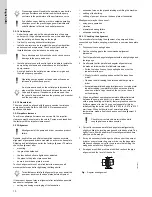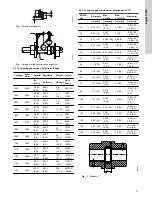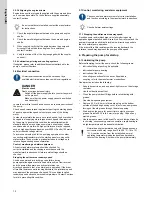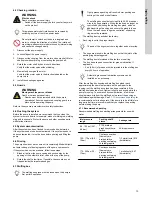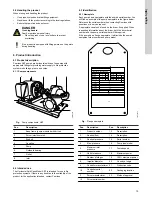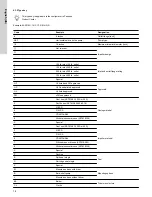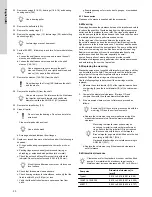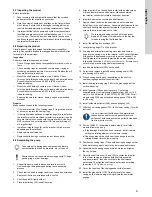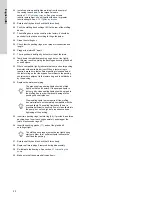
3.4 Installation preparation
3.4.1 Engine preparation
The following installation requirements help to ensure safe and
efficient operation of a pumping unit driven by a diesel engine:
1.
Ensure that the operator is familiar with the installation and
service manual supplied with the engine.
2.
Ventilate the area around the engine to keep the ambient
temperature as low as possible. With 60 °F (15.6 °C) as a data
point, every Δ 10 °F (Δ 6 °C) rise in temperature reduces the
horsepower of the engine by approximately 1%.
3.
Provide adequate air for efficient combustion.
4.
Provide the engine with an efficient exhaust system so that the
combustion gasses discharge with a minimum of back
pressure.
5.
Ensure that the fuel system is of adequate capacity and meets
codes and regulations.
6.
Provide ample space to access the engine for maintenance.
7.
Provide correct rotation of the pump. Engine rotation is
determined at the factory, and no change to engine rotation can
be made in the field.
3.5 Mechanical installation
3.5.1 Pipes and connections
3.5.1.1 Inlet pipe
The inlet pipe must be installed in a manner that minimizes
pressure loss and permits sufficient liquid flow into the pump during
starting and operation.
At no point must the diameter of the inlet pipe be smaller
than that of the pump inlet port.
Observe the following precautions when installing the inlet pipe:
•
Run the inlet pipe as direct as possible, and ideally, make sure
the length is at least ten times the pipe diameter. A short inlet
pipe can be the same diameter as the inlet port. A long inlet
pipe must be one or two sizes larger than the inlet port,
depending on the length, and with a reducer between the pipe
and the inlet port.
•
Use an eccentric reducer, with the tapered side down.
•
If possible, run a horizontal inlet line along an even gradient.
We recommend a gradual upward slope to the pump operating
in suction lift conditions, and a gradual downward slope
operating in positive inlet pressure conditions.
•
Avoid any high points, such as pipe loops, as this may create
air pockets and throttle the system or cause erratic pumping.
•
Install a gate valve in the inlet line to be able to isolate the
pump during shutdown and maintenance, and to facilitate
pump removal. Where two or more pumps are connected to the
same inlet pipe, install two gate valves to be able to isolate
each pump from the pipe.
Always install isolation valves in positions that prevent air
pockets.
Do not use globe valves, particularly when NPSH is a
critical operating factor.
•
During pumping operation, the valves on the inlet line must
always be fully open.
•
Install properly sized pressure gauges in the tapped holes on
the pump inlet and outlet flanges or pipes
Pressure gauges will enable the operator to monitor the
pump performance and determine whether the pump
conforms to the parameters of the performance curve
If cavitation, vapor binding, or other unstable operating
situations occur, the pressure gauges will indicate with
wide fluctuation in the inlet and outlet pressures.
3.5.1.2 Vibration dampers
To prevent the transmission of vibrations to foundations and
surrounding structures, isolate the pump and foundation from
connected structures by means of vibration dampers. The selection
of the correct vibration damper requires the following data:
•
forces transmitted through the damper
•
motor speed(s)
•
required dampening in %.
The selection of a vibration damper differs from installation to
installation. In certain cases, a wrong damper may increase the
vibration level. Peerless recommends that the vibration dampers be
sized by the supplier. If you install the pump on a foundation with
vibration dampers, always fit expansion joints on the pump flanges.
Install expansion joints on the pump flanges to prevent the
pump from "hanging" in the flanges.
3.5.1.3 Inlet pipe
The inlet pipe must be installed in a manner that minimizes
pressure loss and permits sufficient liquid flow into the pump during
starting and operation.
At no point must the diameter of the inlet pipe be smaller
than that of the pump inlet port.
Observe the following precautions when installing the inlet pipe:
•
Run the inlet pipe as direct as possible, and ideally, make sure
the length is at least ten times the pipe diameter. A short inlet
pipe can be the same diameter as the inlet port. A long inlet
pipe must be one or two sizes larger than the inlet port,
depending on the length, and with a reducer between the pipe
and the inlet port.
•
Use an eccentric reducer, with the tapered side down.
•
If possible, run a horizontal inlet line along an even gradient.
We recommend a gradual upward slope to the pump operating
in suction lift conditions, and a gradual downward slope
operating in positive inlet pressure conditions.
•
Avoid any high points, such as pipe loops, as this may create
air pockets and throttle the system or cause erratic pumping.
•
Install a gate valve in the inlet line to be able to isolate the
pump during shutdown and maintenance, and to facilitate
pump removal. Where two or more pumps are connected to the
same inlet pipe, install two gate valves to be able to isolate
each pump from the pipe.
Always install isolation valves in positions that prevent air
pockets.
Do not use globe valves, particularly when NPSH is a
critical operating factor.
•
During pumping operation, the valves on the inlet line must
always be fully open.
•
Install properly sized pressure gauges in the tapped holes on
the pump inlet and outlet flanges or pipes
9
English (US)

